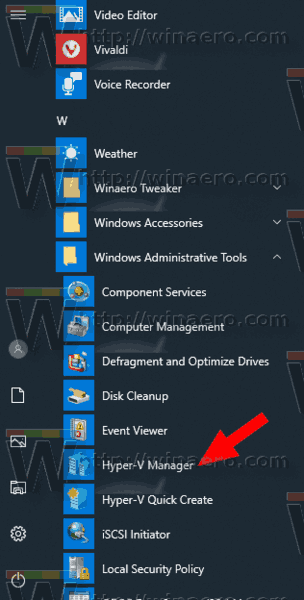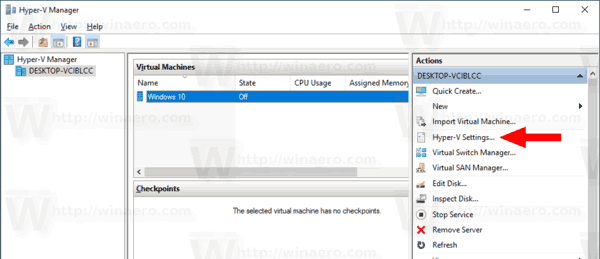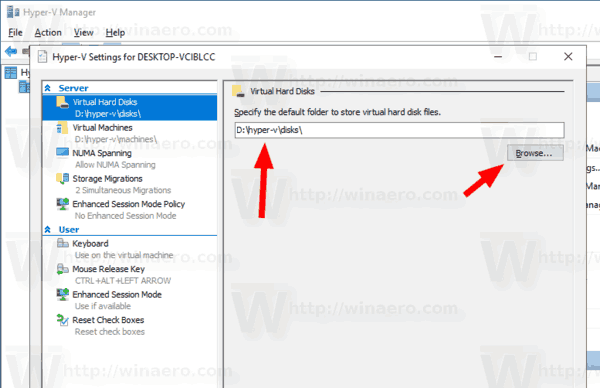Windows 10, Windows 8.1 and Windows 8 come with Client Hyper-V so you can run a supported guest operating system inside a Virtual Machine. Hyper-V is Microsoft's native hypervisor for Windows. It was originally developed for Windows Server 2008 and then ported to Windows client OS. It has improved over time and is present in the latest Windows 10 release as well. Today, we will see how to change the folder which is used to store virtual disks for Hyper-V virtual machines.
Advertisеment
Note: Only Windows 10 Pro, Enterprise, and Education editions include the Hyper-V virtualization technology.
What is Hyper-V
Hyper-V is Microsoft's very own virtualization solution that allows creating virtual machines on x86-64 systems running Windows. Hyper-V was first released alongside Windows Server 2008, and has been available without additional charge since Windows Server 2012 and Windows 8. Windows 8 was the first Windows client operating system to include hardware virtualization support natively. With Windows 8.1, Hyper-V has got a number of enhancements such as Enhanced Session Mode, enabling high fidelity graphics for connections to VMs using the RDP protocol, and USB redirection which is enabled from the host to VMs. Windows 10 brings further enhancements to the native hypervisor offering, including:
- Hot add and remove for memory and network adapters.
- Windows PowerShell Direct – the ability to run commands inside a virtual machine from the host operating system.
- Linux secure boot - Ubuntu 14.04 and later, and SUSE Linux Enterprise Server 12 OS offerings running on generation 2 virtual machines are now able to boot with the secure boot option enabled.
- Hyper-V Manager Down-level management - Hyper-V manager can manage computers running Hyper-V on Windows Server 2012, Windows Server 2012 R2 and Windows 8.1.
Hyper-V Virtual Machine Files
A virtual machine consists of several files, such as configuration files, and virtual disk files that store the guest operating system for a machine. Virtual disk files are the largest files of your VM. By default, Hyper-V stores them on your system partition. If it is a small disk, you may quickly run out of space. In this case, you can move them to another disk or partition.
To change the Hyper-V Virtual Hard Disks folder in Windows 10, do the following.
- Open the Hyper-V Manager from the Start menu. Tip: See How to navigate apps by alphabet in Windows 10 Start menu. It can be found under Windows Administrative Tools > Hyper - V manager.

- Click on your host name on the left.
- On the right, click on the link Hyper-V Settings...

- On the left, select Virtual Hard Disks.
- On the right, specify the desired folder to store the disk files.

You are done.
Alternatively, you can set this folder with PowerShell.
Change the Hyper-V Virtual Hard Disks folder with PowerShell
- Open PowerShell as Administrator. Tip: You can add "Open PowerShell As Administrator" context menu.
- Type or copy-paste the following command:
Set-VMHost -VirtualHardDiskPath 'D:\hyper-v\disks\'
Substitute the path portion with the correct path for your system.
- If you need to change the folder for a remote system, execute the following command:
Set-VMHost -ComputerName 'remote host name' -VirtualHardDiskPath'D:\hyper-v\disks\'
That's it!
Related articles:
- Remove Floppy Disk Drive in Windows Hyper-V Virtual Machine
- Change DPI of Hyper-V Virtual Machine (Display Scaling Zoom Level)
- Create Shortcut for Hyper-V Virtual Machine in Windows 10
- Enable or Disable Hyper-V Enhanced Session in Windows 10
- How to Enable and Use Hyper-V in Windows 10
- Create Ubuntu Virtual Machines with Hyper-V Quick Create
Support us
Winaero greatly relies on your support. You can help the site keep bringing you interesting and useful content and software by using these options:
